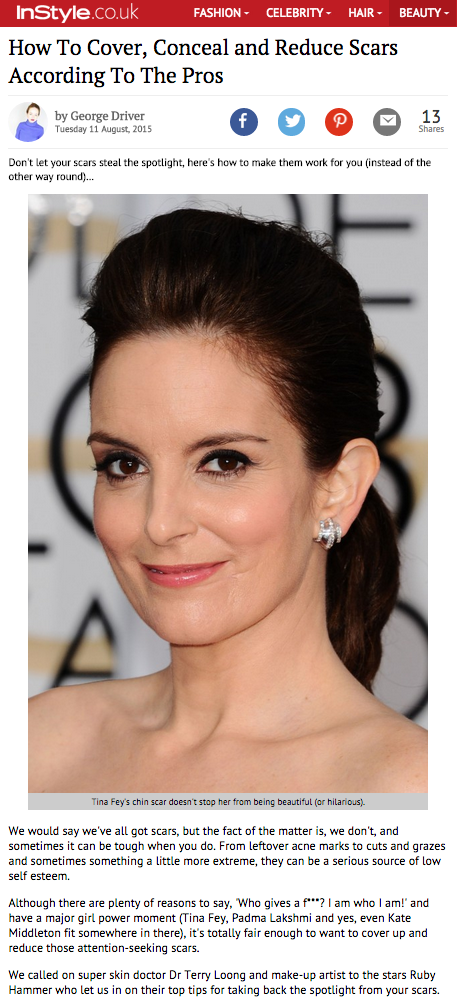
We would say we’ve all got scars, but the fact of the matter is, we don’t, and sometimes it can be tough when you do. From leftover acne marks to cuts and grazes and sometimes something a little more extreme, they can be a serious source of low self esteem.
Although there are plenty of reasons to say, ‘Who gives a f***? I am who I am!’ and have a major girl power moment (Tina Fey, Padma Lakshmi and yes, even Kate Middleton fit somewhere in there), it’s totally fair enough to want to cover up and reduce those attention-seeking scars.
We called on super skin doctor Dr Terry Loong and make-up artist to the stars Ruby Hammer who let us in on their top tips for taking back the spotlight from your scars.
Over to Dr Terry!
Are there different types of scars?
‘Yes there is! There are:
1. Flat Scars – scars that heal well, they function like normal skin and the colour goes back to the normal skin tone in time.
2. Hypertrophic Scars – scars that occur due to an imbalance in collagen production in the injured area creating a scar that is often thicker but does not extend beyond the boundary of the original injury.
3. Keloid Scars – scars that occur due to overgrowth of healing tissues. The scar grows beyond the boundary of the original injury, sometimes even after the injury has healed.
4. Pitted or Sunken Scars – often from acne or chicken pox. This can also occur due to an injury leading to underlying loss of fat, creating an uneven undulated surface.
5. Scar Contractures – this is when the healed skin shrinks and contracts, restricting movement and causing tightness. This usually occurs with burns.
6. Stretch Marks – although considered a scar, there are actually caused by sudden stretching of the skin e.g. pregnancy, growth spurt, weight gain which causes the middle layer of the skin (dermis) to break in places, allowing the deeper layers to show through.’

How can they be reduced?
‘During the healing process, increase your intake of anti-oxidants – vitamins, especially A, C and E, minerals like selenium, sulphur and zinc, and plenty of healthy fats. You can get these from eating fresh vegetables and fruits, oysters (if you’re not allergic to them), avocado and salmon. All of these will help the healing process. Stop smoking or stay away from secondary smoke as smoking increases the breakdown of collagen and reduces proper healing.
Once the injury has completely healed, massage the skin with Vitamin E oil. Apply sunscreen every day and stay out of direct sunlight. You can also apply Vitamin C and Vitamin A cream to help smooth the scar and even it’s tone.’
WE LOVE: Decleor’s Aroma Solutions Prolagene Gel, £30.60 and Bio-Oil 200ml, £13.33

What professional help is there?
‘Depending on the type of scar, how deep and how extensive it is, there are different options.
To resurface the scar – microdermabrasion, micro needling, lasers (e.g. fraxel and CO2) and chemical peels.
To plump up the scar (for sunken or pitted scars) – subcision, dermal filling or TCA crosses.’
What can you do at home?
‘Exfoliating regularly once it’s healed will help. Also massaging with a good antioxidant like Vitamin E. Alternatively, you can use lotions with lactic acids or glycolic acid pads to help soften the skin which eases the massage process.
WE LOVE: Malin + Goetz Resurfacing Glycolic Pads, £38 and Eucerin Dry Skin Replenishing Cream, £9.75

So that’s the skin stuff sorted, what about makeup? Ruby Hammer reveals all…
What tips and tricks are there for covering up scars?
‘For scars on your face, apply a thin base all over like Vichy Dermablend Fluid Foundation, £18 then dot on a heavy concealer over the scar. Soften the area around the scar by blending Laura Mercier’s Secret Camouflage, £26.50 well before setting it with powder to stop it budging. Bear in mind that flat scars are easier to conceal than raised ones. To help apply product to scars, use a tiny brush and then a medium one for more coverage. For body scars, Vichy’s Total Body Corrective Foundation, £29.50 is great. But my top tip is to use makeup to draw attention to other features instead of piling it on scars to cover them up.’

What should you avoid when doing your makeup if you’ve got scars?
‘Don’t go too heavy with your all over base, thin layers work better to cover or camouflage scars. Also make sure the colour of the concealer or foundation is appropriate and matches your skin tone. To stop scars getting darker, always wear a base that contains SPF and avoid strong products that irritate the skin.’